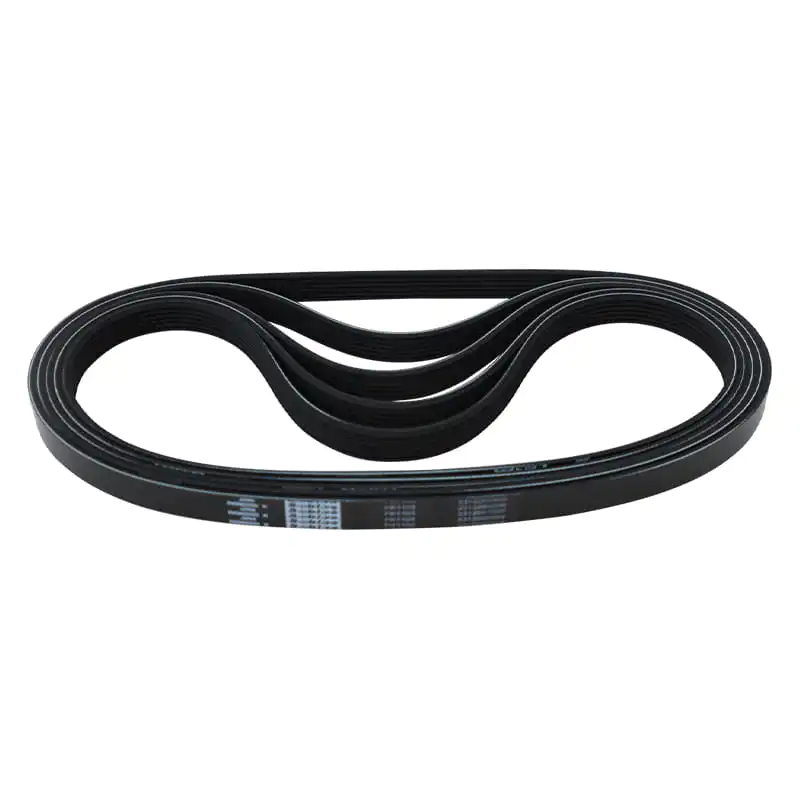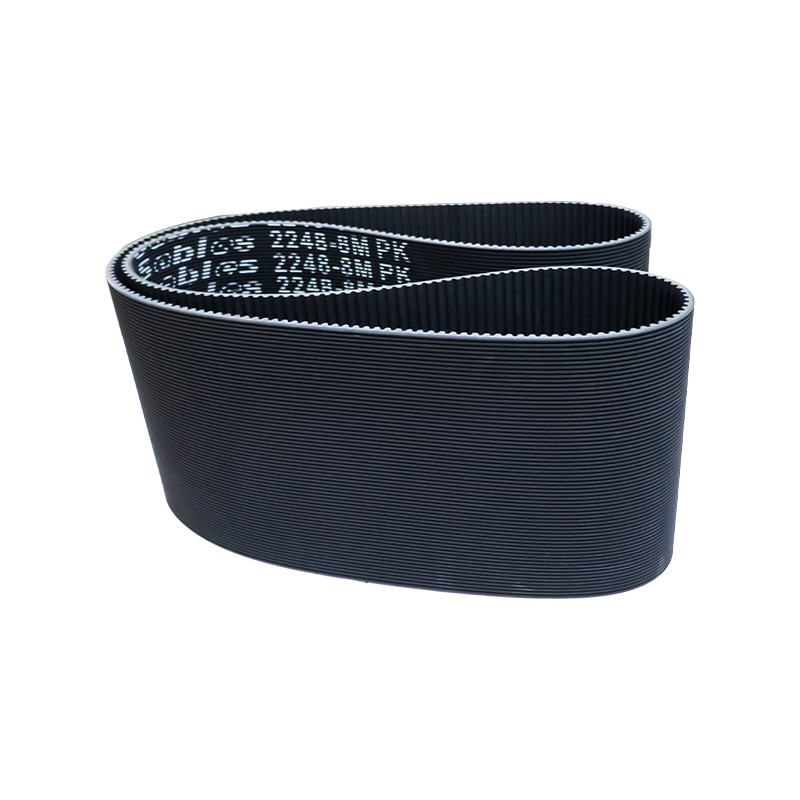Rubber V-belts and wide-angle belts both transmit power, but they differ in design and use. Let’s clarify with key questions.
Do Their Designs Impact How They Work?
Yes, design differences change performance:
Cross-section: V-belts have a steep trapezoidal shape (30–40° angle) that grips pulley grooves tightly, while wide-angle belts are flatter with a smaller angle (10–20°) for broader contact.
Durability: V-belts resist stretching for high tension, while wide-angle belts (some with notched inner surfaces) are more flexible, handling small pulley bends better.
Are Their Power Transmission Abilities Different?
They excel in different scenarios:
V-belts: Good for high-torque, low-speed tasks (e.g., industrial compressors, tractors) — their groove grip transmits more power per width.
Wide-angle belts: Ideal for high-speed, low-torque use (e.g., washing machines, printers) — they reduce centrifugal force and run quieter at speeds up to 5,000 RPM.
Do They Have Distinct Real-World Uses?
Yes, based on their strengths:
V-belts: Used in heavy-duty machinery (agricultural harvesters, conveyor systems) where torque matters and alignment is precise.
Wide-angle belts: Fit for household/appliance use (dryers, copiers) and light industrial gear (small fans) — they tolerate slight pulley misalignment (up to 3°) for less maintenance.
What Are the Differences and Applications of Rubber V-belts and Wide-angle Belts?
Products Recommended
-


Rubber Wide - Angle Belt
View MoreThe wide-angle belt is a new type of industrial transmission belt developed on the basis of the general industrial V-belt technology.They are all driven by the friction diagram on both sides of the belt. The wedge angle of the general V-belt is 40° and the wedge angleof the wide-angle transmission belt is 60°.According to the principle of transmission dynamics, as the wedge angle of the wide-angle belt increases, the area supported by thetwo transmission sides naturally increases, thus giving rise to the following advantages over the general V-belt:1. The load of the wide-angle belt is evenly distributed and the wear resistance is improved.2. The contact area between the belt and the pulley increases and the transmission force is increased.3. It improves the concave deformation of the drive belt core and strengthens the drive characteristics.4. After the wide-angle belt is installed and used, the problem of belt tension drop is improved.It is the above-mentioned advantages of the wide-angle belt that are widely used and affirmed by the precision machinery industry. -


Rubber Conveyor Belt
View MoreThe conveyor belt is composed of surface adhesive, core, and layer glue. In addition, a layer of buffer cloth can be added to the use of high drop impact to make it more impact-resistant.
The surface adhesive
With natural rubber and synthetic rubber as raw materials and in order to enhance wear resistance, crack resistance, aging resistance, and other properties, the surface adhesive has various characteristics such as wear resistance, cutting resistance, heat resistance, flame resistance, cold resistance, acid and alkali resistance, oil resistance, static electricity resistance and so on.
Cloth layer core
The cloth layer is composed of natural fiber or chemical fiber alone or a combination of the two, has the same quality after single-step treatment by a mature process, And has good adhesion with rubber.
The adhesive layer
The adhesive layer is very important for the adhesive force between the layers of the core of the conveyor belt that is repeatedly flexed. Especially for high-tension conveyor belts, a layer of adhesive with less buckling stress and less fatigue due to internal stress must be used.
Specifications and models can be customized according to customer requirements, with a thickness ranging from 2.0 mm to 8.0 mm. -


Endless Rubber Flat Belt
View MoreBelt type:
FH FL FM
Scope of application:High-speed, smooth, and low-extension transmission and conveying systems, such as textile machinery, woodworking machinery, grinding machinery, ticket vending machines, vegetable cutting machines, etc.
Characteristics:
High speed and stability, high tensile strength, and low elongation. -


Silicone Belt
View MoreBelt type:
Integrated Vulcanized Silicone Flat Belt and Silicone Synchronized Belt
Scope of application:Sanitary products industry, glass machinery, sealing machine, etc.
Characteristics:
Anti-sticking, high friction coefficient, and high-temperature resistance. -


Endless Rubber Sanding Machine Belt
View MoreThe seamless rubber band produced by woodworking machinery can be used for sanding, correcting, and trimming core materials, planing wood boards, laminated boards, plastic laminated boards, and other machines, and can help the surface to be perfectly machined and selected.
Its special technology lies in the manufacturing method and produces the required size jointless belt. We not only strictly control the quality, but also insist on using imported materials in order to make our sander belt have better performance.
All parts of thickness and strength are absolutely uniform.It has a good linear operation.High flexibility can be used for small wheel diameters.It can maintain flatness and non-deformability under working pressure.The friction coefficient between the bottom of the belt and the plate surface is very low.Because the surface layer of the belt is covered with rubber, the adhesiveness is improved and the stability of the conveyor belt is improved. -


Synchronous Pulley
View MoreScope of application:
Apply to each field of the synchronous-driven device system.
Characteristics:
Ensure coordination with the belt, to enhance the accuracy and lifetime of the driven. According to customer requirements, customization optimum driven solution can divided into 45# steel, aluminium alloy, stainless steel, cast iron, nylon, etc, according to the material. -


Ribbed Belt
View MoreBelt type:
PHPJPKPLPM
Scope of application:It is suitable for outdoor transmission equipment, transportation equipment, medical equipment, electric tools, household appliances, and sports equipment.
Characteristics:
1. The transmission power of the ribbed belt is higher than that of an ordinary V-belt by 30 % when the space is the same.2. The transmission system of the ribbed belt has a compact structure, and under the same transmission power, the space occupied bythe transmission device is 25 % smaller than that of the common V-belt.3. The ribbed belt is thin and flexible and is suitable for transmission with a small pulley diameter and high-speed transmission, with beltspeed up to 40m/ s; Small vibration, less heat, and stable operation.4. The ribbed belt is heat-resistant, oil-resistant, and wear-resistant, with small elongation and a long service life. -


Toothed And Ribbed Belt
View MoreBelt type:
8MPK S8MPK
Scope of application:Flour mill, pulverizer, etc.
Characteristics:
1. One side of the tooth wedge belt is a ribbed belt and the other side is a synchronous belt.2. Double-sided transmission capable of meeting special working conditions.





